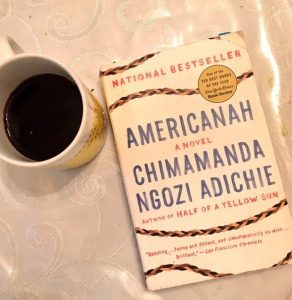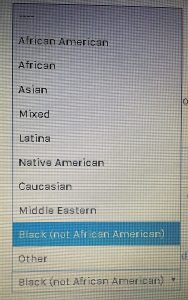This is the standard race and ethnicity checklist that everyone has probably had to fill out, on one official document or another:
Race /Ethnicity (circle one):
American Indian or Alaska Native
Asian
Black or African American
Hispanic or Latino
Native Hawaiian or Other Pacific Islander
Not a lot of people pay it much mind, but I do. Frankly, filling it out has always felt like a set-up. I have no choice but to tell a half-truth—for the sake of someone else’s demographics chart. If I stare at the list for too long, it gets even more confusing:
Why do they set up race and ethnicity to be interchangeable? What’s the difference, anyway?
What if there was an ‘and’ between the ‘Black’ and ‘African American’ categories? Would I feel better about them being in the same category?
What even am I ?! WHY IS THIS SO HARD?!
Here’s my dilemma: lists like these are setting up ‘Black’ and ‘African American’ as though they’re one and the same. I understand that this may be an easy way to group people together by skin color, for the sake of a diversity chart, but not every black person in the United States is African-American.
In my case, I am a black, American-born citizen, but I am also a first-generation Haitian American. Haiti is one of the many Caribbean countries that exist as a result of the African diasporic migrations. I am a product of a particular migration of African peoples to the West Indies, but technically I’m not of direct African descent. As for my American-ness, I am American by birth but not by culture since I was raised in Haitian customs and traditions. At best, ‘Afro-Carribbean’ would be the most accurate way to describe my ethnicity, moreso than ‘African-American.’
Unfortunately, not everyone’s ‘most accurate’ is an option—unless they’re willing to write in the classification they prefer at the bottom of every checklist they come across. Instead, they settle for the next, more tangential option with which they may or may not agree. For most of my life, I was also willing to settle. I believed there was no other choice.
Until I read Americanah by Chimanda Ngozi Adichie.
In the novel, Adichie creates a new way to both racially and ethnically classify her black characters: ‘American-Black’ and ‘Non-American Black’ (AB and NAB). I immediately identified with both of these; their sudden intrusion into my life felt like putting names to two familiar, elusive faces. I’ve never been able to define the wishy-washy, in-between space that I occupy so clearly before. Neither term is as vaguely concrete as ‘Black’ or as confusing as ‘African American.’ If anything, they expand the reach of their limited predecessors. An American-born black person who might consider themselves too removed from potential African ancestors can use the term ‘American Black’ instead of African American. Similarly, the use of the term ‘Non-American Black’ could unlock a new cultural identity for Pan-African and Afro-Latino immigrants, as well as for first generation Americans like myself, who had previously considered themselves invisible among other black people.
It is important to remember that AB and NAB are not perfect terms; there are people of direct and indirect African descent who are not black at all. Still, the way in which Adichie creates these new categories and incorporates them into the structure of her novel is an important call to action in the struggle for cultural visibility. If you can’t find yourself on the standard list, you can always create new categories, and in turn, a new list.


